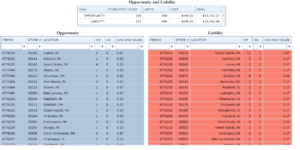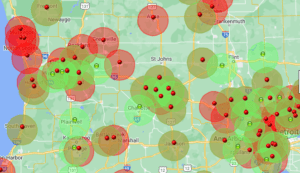Measuring Inventory Opportunity and Liability
[ad_1]
By Jim Lewis, CEO Enhanced Retail Solutions LLC
Our superpower is studying sales and inventory at store level by SKU. Our goal is determining the optimal inventory required to generate the maximum rate of sale. With many retailers becoming more cautious with their planning, it’s important to understand how reducing inventory levels may affect your business.
Opportunities and Liabilities
Reviewing opportunities and liabilities is a good way to determine if inventory is balanced across stores. An opportunity is any SKU-store combination that doesn’t have enough inventory. It represents an opportunity to sell more. A liability is any SKU-store combination that has too much inventory. This is determined by measuring how many weeks of supply each store has for a particular SKU.
Defining the Benchmarks
First you must define the benchmarks. These include the range of optimal inventory, under-inventory level (opportunity) and over-inventory level (liability). Then you can compare each SKU-store’s actual inventory against the benchmarks. For example, let’s say the target optimal inventory is between 8-12 weeks of supply. An opportunity is anything under 6 weeks of supply. A liability is anything over 16 weeks of supply. Yes, there are some gaps but that is because we just want to focus on the extreme cases of under and over inventory.
Assigning Values
Once each SKU-store’s scenario has been assigned, the value of the opportunities and liabilities can be determined. This is like a financial balance sheet- assets versus debts. In this example we can see the retail value of opportunities is $10,752 while the liability is $15,743. In this case the liabilities outweigh the opportunities. Knowing exactly where to cut and where to add inventory is the quickest way to increase turnover and generate more revenue.

SKU-Store Inventory Opportunity and Liability
Taking Action
Suppliers should share this information with their retail planning partners. It reduces risk by targeting the top selling stores and ensuring no more inventory is fed to the poor performers. In general, fixing opportunities is easier than liabilities. The most optimal situation is transferring inventory from liability stores to opportunity stores, but that’s not easy for most retailers. If you have merchandise ready to ship, you can prioritize shipments to the opportunity stores. Adjust presentation in liability stores. Other options include conducting local promotions or pulling on-line orders from those stores first.
This exercise is also helpful when allocating new, similar products. For example, it can be used as a guide to more optimally set stores. Sometimes demographics or geography play a role. Showing the opportunity and liability stores on a map is a great way to visualize that.

Green Dots are opportunities, Red Dots are liabilities
Want to learn more about how you can automate an Opportunity and Liability report? Click here to learn more about our Best Practices reporting.
[ad_2]
Source link
